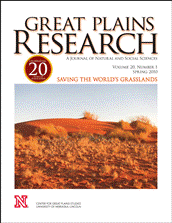Center for Great Plains Studies

Great Plains Research: A Journal of Natural and Social Sciences (through 2013)
Date of this Version
Spring 2005
Document Type
Article
Abstract
Stephen Ambrose would he proud! During this bicentennial commemoration of the most intrepid expedition in American history, a plethora of hooks on a broad range of topics dealing with the "Journey or Lewis and Clark" have made their appearance. Hoganson and Murphy have taken an intriguing look at one segment or the journey-the physical environment or North Dakota where the expedition spent more time (213 days) than in any other area that would become a state during its two-and-a-half-year-long journey from St. Louis to the Pacific Ocean. As mandated by Thomas Jefferson, a major goal or the expedition was to observe and record geology, to collect rock, mineral, and fossil samples, and to assess the potential for economic reserves along the four-thousand-mile route. Hoganson and Murphy deftly combine the history and geology of the Northern (Great Plains in a well-written. lavishly illustrated text. The book is chock-full or photographs, diagrams, maps, and tables that present the geological and historical story in a visually concise and comprehensible manner. The authors also include a convenient glossary and have smartly divided their bibliography into two sections: the first citing those works dealing with the historical aspects covered in the book, the second listing texts concerned with North Dakota and Northern Great Plains geology.


Comments
Published in Great Plains Research Vol. 15, No. 1, 2005. Copyright © 2005 The Center for Great Plains Studies, University of Nebraska–Lincoln. Used by permission.